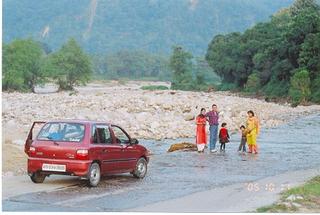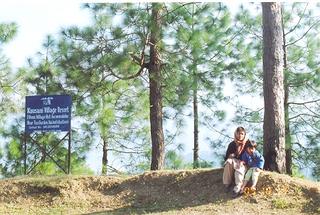Jim Corbett is a legend in Kumaon. He had left his footprint all across Kumaon saving lesser mortals from the jaws of man-eater tigers. Come to Ramnagar and you will feel the legend. The word Corbett had to be there somewhere in the names of any hotel, resorts or restaurants. Affectionately called the Carpet Sahib by local villagers, he seemed to be equally popular or may be better known than the father of the nation in this area. We had read about him in school, probably in class VII. It felt great to be at Arundel, his house at Kaladhungi which is now a museum run by the Corbett National Park. On our way back, we got the opportunity to travel by NH121 that runs right through the national park.
The Corbett Museum, Kaladhungi :
This is Arundel, the winter home of the Corbetts located at Kaladhungi. It is on the Kashipur -Bazpur - Haldwani road. Corbetts used to live in Nainital during summer and came down to kaladhungi during winters. A shortcut to Nainital starts right infront of the house. Nainital is just 32 km from this point and we travelled by this road to Nainital.
The house is located on a spreawling 10 acre complex. There are two seperate houses located close by. Few of Corbett's belongings are on display. In one section, there are some paintings depicting his life. The museum remains open upto 5 pm in summer. The gate fees charged is 5 rupees for adult and 1 rupees for child. It is managed by the forest deptt.
If you are a Corbett fan, you should not miss this. There is a luxury resort named Corbett Camp Jungle Lore very close this museum. But honestly speaking, this place is very far away from the actual Corbett National Park, around 30 km. The visit had renewed my interest in Jim Corbett. I came across many stratling facts whcih were not available in our school book. I had compiled a brief on the life of Jim Corbett which I share with you. If you are planning a visit to the park, you should know about this great gentleman.
The life of Jim Corbett (1875 - 1955) :
He was born as Edward James Corbett on 25 July, 1875 at Nainital. His father Christopher William Corbett had left military service and moved to Mussorie in 1858 where he got the job of postmaster in Mussorie. There he met Mary Jane who also had moved to Mussorie after lsoing her husband in the sepoy mutiny of 1857. They got married on Oct 13, 1859. Therafter he was transferred to Nainital in 1862 (and it took almost a month for the family to relocate). Jim lost his father when he was just 6. He wrote about how his mother Mary Jane had to struggle to bring the children up. They in fact had very large family. Jim’s parents had a total of 14 child of which 8 were from their wedlock and 6 (3 each) from there first marriages.
His brother Tom used to take young Jim into jungle for hunting for food. It is Tom from whom he leaned the first lesson in hunting. Growing up with the jungles made him a master of the jungles. Corbett started with a catapult to shoot down birds. He got his first gun, a double barreled muzzle loader, from his cousin Stephen Dease as a gift. Stephen wrote a book on birds of Kumaon and Jim collected more than 100 specimens for him with his catapult. He shot his first leopard when he was just eight. His reputation grew fast in Kumaon and received his first request to track a man-eater in 1906. The first man eater he killed was the Champawat Tiger in 1907. Between 1906 and 1941, he had slayed ten man-eaters in different parts of the Kumaon region of Uttaranchal.
request to track a man-eater in 1906. The first man eater he killed was the Champawat Tiger in 1907. Between 1906 and 1941, he had slayed ten man-eaters in different parts of the Kumaon region of Uttaranchal.
Corbett was not just a hunter. He was a naturalist. He loved the wild and respected the big cat. He never killed a tiger for money or fun. He killed only the man-eaters to save lives. He was affectionately referred to by the locals as Carpet Sahib who would search jungles with inhospitable terrains for days in the trail of that eluding man-eater tiger. The combined total number of people killed by the man-eaters Corbett hunted exceeded 1500. The Champawat tiger itself had killed 436 documented victims. Similarly, the man eating leopard of Rudraprayag (see the photograph), killed in 1925, had 114 victims to its name. Deeply pained at the growing number of hunters and destruction to wildlife, he campaigned for the need to preserve the wildlife and devoted his later part of life for this purpose. He helped create the Association for the Preservation of Game in the United Provinces, and the All-India Conference for the Preservation of Wild Life, and he established India's first national park, inaugurated in 1934 in the Kumaon Hills as the Hailey National Park. This has been renamed in his honour as the Corbett National Park. In later part of his life he also took to wildlife photography.
Corbett was also a keen entrepreneur. After schooling, he joined the services of Bengal and North Western Railway at the age of 17. After few years he left service and started his own business. He had acquired a company called FEG Mathews & Co. for carrying out his business. He also started a large farm in a village near Kaladhungi. The farm is located in a village called ‘Chotha Haldwani’ is now a tourist spot. He owned many houses in Nainital where the Corbett household were settled. Corbett family had an established real estate business in Nainital which Jim carried forward. In fact his mother was said to be the first real estate agent of Nainital. Corbetts had a house in Kaladhungi where they lived during winters. It was built by his father.
The life of Jim Corbett (1875 - 1955) :
He was born as Edward James Corbett on 25 July, 1875 at Nainital. His father Christopher William Corbett had left military service and moved to Mussorie in 1858 where he got the job of postmaster in Mussorie. There he met Mary Jane who also had moved to Mussorie after lsoing her husband in the sepoy mutiny of 1857. They got married on Oct 13, 1859. Therafter he was transferred to Nainital in 1862 (and it took almost a month for the family to relocate). Jim lost his father when he was just 6. He wrote about how his mother Mary Jane had to struggle to bring the children up. They in fact had very large family. Jim’s parents had a total of 14 child of which 8 were from their wedlock and 6 (3 each) from there first marriages.
His brother Tom used to take young Jim into jungle for hunting for food. It is Tom from whom he leaned the first lesson in hunting. Growing up with the jungles made him a master of the jungles. Corbett started with a catapult to shoot down birds. He got his first gun, a double barreled muzzle loader, from his cousin Stephen Dease as a gift. Stephen wrote a book on birds of Kumaon and Jim collected more than 100 specimens for him with his catapult. He shot his first leopard when he was just eight. His reputation grew fast in Kumaon and received his first
 request to track a man-eater in 1906. The first man eater he killed was the Champawat Tiger in 1907. Between 1906 and 1941, he had slayed ten man-eaters in different parts of the Kumaon region of Uttaranchal.
request to track a man-eater in 1906. The first man eater he killed was the Champawat Tiger in 1907. Between 1906 and 1941, he had slayed ten man-eaters in different parts of the Kumaon region of Uttaranchal.Corbett was not just a hunter. He was a naturalist. He loved the wild and respected the big cat. He never killed a tiger for money or fun. He killed only the man-eaters to save lives. He was affectionately referred to by the locals as Carpet Sahib who would search jungles with inhospitable terrains for days in the trail of that eluding man-eater tiger. The combined total number of people killed by the man-eaters Corbett hunted exceeded 1500. The Champawat tiger itself had killed 436 documented victims. Similarly, the man eating leopard of Rudraprayag (see the photograph), killed in 1925, had 114 victims to its name. Deeply pained at the growing number of hunters and destruction to wildlife, he campaigned for the need to preserve the wildlife and devoted his later part of life for this purpose. He helped create the Association for the Preservation of Game in the United Provinces, and the All-India Conference for the Preservation of Wild Life, and he established India's first national park, inaugurated in 1934 in the Kumaon Hills as the Hailey National Park. This has been renamed in his honour as the Corbett National Park. In later part of his life he also took to wildlife photography.
Corbett was also a keen entrepreneur. After schooling, he joined the services of Bengal and North Western Railway at the age of 17. After few years he left service and started his own business. He had acquired a company called FEG Mathews & Co. for carrying out his business. He also started a large farm in a village near Kaladhungi. The farm is located in a village called ‘Chotha Haldwani’ is now a tourist spot. He owned many houses in Nainital where the Corbett household were settled. Corbett family had an established real estate business in Nainital which Jim carried forward. In fact his mother was said to be the first real estate agent of Nainital. Corbetts had a house in Kaladhungi where they lived during winters. It was built by his father.
Jim Corbett had also served in the army and took part in 4 wars. He had raised a battalion of Kumaoni locals and took few of them to fight in France in 1917. In 1939 Corbett volunteered to take part in the WW-II and trained allied soldiers in jungles survival in Burma. But the stress took a heavy toll of ageing Corbett. He had infected both Typhoid and Malaria during this period. After recuperating, he started penning his hunting stories. His first book, The Man-Eaters of Kumaon (1946), turned out to be best seller and has been translated into more than 30 languages., The Man-Eating Leopard of Rudraprayag (1948), and the Temple Tiger and More Man-Eaters of Kumaon (1954). He finally retired to Kenya with his sister Maggie (Margaret Winifred) in 1947. He had a special bond with Maggie among all his siblings right from his childhood. There he took up farming and continued to write. He died there of heart attack in 1955.
Want to know more. This site on Jim Corbett put up by Corbett Study Group had a very detailed description of Corbett’s life.
Want to know more. This site on Jim Corbett put up by Corbett Study Group had a very detailed description of Corbett’s life.


